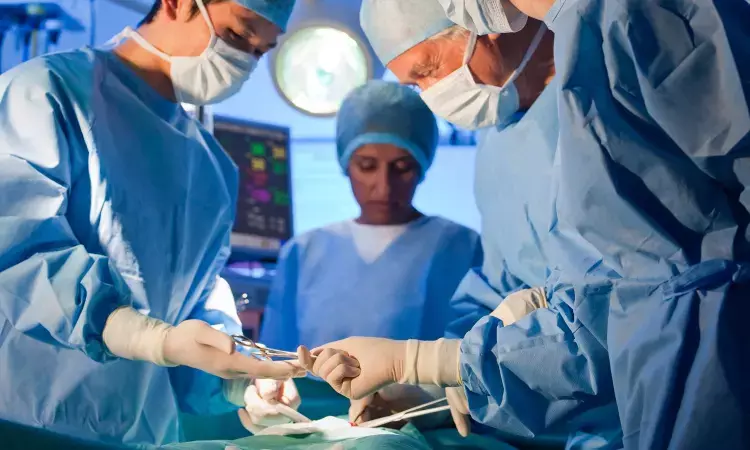- Home
- Medical news & Guidelines
- Anesthesiology
- Cardiology and CTVS
- Critical Care
- Dentistry
- Dermatology
- Diabetes and Endocrinology
- ENT
- Gastroenterology
- Medicine
- Nephrology
- Neurology
- Obstretics-Gynaecology
- Oncology
- Ophthalmology
- Orthopaedics
- Pediatrics-Neonatology
- Psychiatry
- Pulmonology
- Radiology
- Surgery
- Urology
- Laboratory Medicine
- Diet
- Nursing
- Paramedical
- Physiotherapy
- Health news
- Fact Check
- Bone Health Fact Check
- Brain Health Fact Check
- Cancer Related Fact Check
- Child Care Fact Check
- Dental and oral health fact check
- Diabetes and metabolic health fact check
- Diet and Nutrition Fact Check
- Eye and ENT Care Fact Check
- Fitness fact check
- Gut health fact check
- Heart health fact check
- Kidney health fact check
- Medical education fact check
- Men's health fact check
- Respiratory fact check
- Skin and hair care fact check
- Vaccine and Immunization fact check
- Women's health fact check
- AYUSH
- State News
- Andaman and Nicobar Islands
- Andhra Pradesh
- Arunachal Pradesh
- Assam
- Bihar
- Chandigarh
- Chattisgarh
- Dadra and Nagar Haveli
- Daman and Diu
- Delhi
- Goa
- Gujarat
- Haryana
- Himachal Pradesh
- Jammu & Kashmir
- Jharkhand
- Karnataka
- Kerala
- Ladakh
- Lakshadweep
- Madhya Pradesh
- Maharashtra
- Manipur
- Meghalaya
- Mizoram
- Nagaland
- Odisha
- Puducherry
- Punjab
- Rajasthan
- Sikkim
- Tamil Nadu
- Telangana
- Tripura
- Uttar Pradesh
- Uttrakhand
- West Bengal
- Medical Education
- Industry
Management of postoperative pain in non traumatic emergency surgery: WSES guidelines

Italy: Four organizations in collaboration have released clinical guidelines on managing postoperative pain in nontraumatic emergency surgery.
The clinical guidelines, published in the World Journal of Emergency Surgery, were released jointly by the Global Alliance for Infection in Surgery (GAIS), World Society of Emergency Surgery (WSES), Analgesia Intensive Care (SIAARTI), Italian Society of Anesthesia, and American Association for the Surgery of Trauma (AAST).
Nonopioid and Opioid Drugs
- The use of opiates should be reduced as much as possible. Multimodal analgesia should always be considered; a step-up approach that includes significant opiates when necessary should be adopted.
- In the absence of contraindications, acetaminophen, nonsteroidal anti-inflammatory drugs (NSAIDs), and gabapentinoids are recommended in multimodal analgesia. Acetaminophen given at the start of postoperative analgesia may be superior. Coxibs may be considered if there are no contraindications.
- Major opiates are indicated for moderate-to-severe pain, unresponsive to other drugs, and in which regional anesthesia is not indicated.
- In opioid-naïve patients, initial opioid infusion via intravenous (IV) patient-controlled analgesia (PCA) should be avoided. If indicated, opiate infusion via IV PCA should be preferred to spinal PCA whenever the IV route is viable.
Route of drugs administration
- Whenever feasible, oral administration should be preferred over IV administration. The intramuscular (IM) route should be avoided. Epidural and regional anesthesia is recommended in general emergency surgery whenever feasible and does not delay emergency procedures.
- Neuraxial administration of magnesium, benzodiazepines, neostigmine, tramadol and ketamine should be avoided.
Perioperative Nerve Block and Local Infiltration
- In both adults and children, regional anesthesia is adequate. Abdominal-wall block can be considered to have an opioid-sparing effect. The transversus abdominis plane (TAP) block is safe and effective in laparoscopic abdominal surgery; the rectus sheath block is a viable alternative.
- Local wound infusion is suggested as a component of multimodal analgesia.
Pain Assessment
- Periodic assessment of pain with validated systems is mandatory. Observational pain scales are less reliable than patient-reported metrics but should still be applied in non-communicative patients.
Drug Therapy
- Multimodal analgesia is suggested to treat moderate-to-severe pain in (1) patients not amenable to surgical intervention and (2) patients already operated on but unsuitable for further interventions. For (2), a combination of systemic multimodal analgesia with regional analgesia is suggested. For both (1) and (2), palliation should be considered to achieve control of related symptoms (e.g., nausea, vomiting, dyspnea, agitation, delirium).
The researchers wrote in their conclusion, "dealing with postop pain in the settings of emergency abdominal surgery is complex, needs special attention, and should be multidisciplinary. Various tools are available, and their combination is necessary whenever possible."
"Analgesic approach to several situations and conditions should be patient based and tailored per the pathology, procedure, response, age, and available expertise," they added. "It is necessary to better understand the pathomechanisms of postoperative pain for short- and long-term outcomes to improve prophylactic and treatment strategies."
Reference:
Coccolini F, Corradi F, Sartelli M, Coimbra R, Kryvoruchko IA, Leppaniemi A, Doklestic K, Bignami E, Biancofiore G, Bala M, Marco C, Damaskos D, Biffl WL, Fugazzola P, Santonastaso D, Agnoletti V, Sbarbaro C, Nacoti M, Hardcastle TC, Mariani D, De Simone B, Tolonen M, Ball C, Podda M, Di Carlo I, Di Saverio S, Navsaria P, Bonavina L, Abu-Zidan F, Soreide K, Fraga GP, Carvalho VH, Batista SF, Hecker A, Cucchetti A, Ercolani G, Tartaglia D, Galante JM, Wani I, Kurihara H, Tan E, Litvin A, Melotti RM, Sganga G, Zoro T, Isirdi A, De'Angelis N, Weber DG, Hodonou AM, tenBroek R, Parini D, Khan J, Sbrana G, Coniglio C, Giarratano A, Gratarola A, Zaghi C, Romeo O, Kelly M, Forfori F, Chiarugi M, Moore EE, Catena F, Malbrain MLNG. Postoperative pain management in non-traumatic emergency general surgery: WSES-GAIS-SIAARTI-AAST guidelines. World J Emerg Surg. 2022 Sep 21;17(1):50. doi: 10.1186/s13017-022-00455-7. PMID: 36131311; PMCID: PMC9494880.
Dr Kamal Kant Kohli-MBBS, DTCD- a chest specialist with more than 30 years of practice and a flair for writing clinical articles, Dr Kamal Kant Kohli joined Medical Dialogues as a Chief Editor of Medical News. Besides writing articles, as an editor, he proofreads and verifies all the medical content published on Medical Dialogues including those coming from journals, studies,medical conferences,guidelines etc. Email: drkohli@medicaldialogues.in. Contact no. 011-43720751


